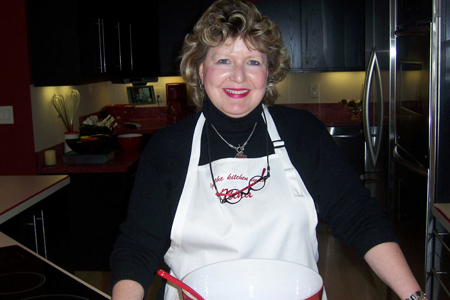
The town of Robins, Iowa is not likely to come up on your search engine for must-make culinary stops. With a population of about 2,000, this small midwestern town sits on the border of Cedar Rapids, a working class city known for its Quaker Oats headquarters, corn mills and some large techy type corporations. Still, scratch the surface, take a moment to get to know Nina (nine-ah) Swan-Kohler, a highly experienced chef whose cranberry red and black deco home in Robins likely makes the hair on the local farmers stand on end.
Nina invited me into her kitchen where she teaches classes almost nightly. We would talk about “all things tropical” as a six month exchange program in Trinidad and Tobago would shape significantly her love of exotic foods.
A native of Missouri, Nina began cooking at the age of three, when her mother let her help bake. She would go on to major in home economics in college, her first professional job being a home economist for the dairy industry. Later earning a Master’s degree in foods, nutrition and communication she would work for the Missouri Department of Agriculture while developing marketing programs for food companies.
Her career continued to evolve as she moved into advertising, providing culinary guidance for clients. Currently she owns her own public relations company. But the kitchen calls to her.
Island Girl
Nina invited me into her kitchen where she teaches classes almost nightly. She has prepared a thorough menu for her students, who will be coming to get a sample of the Caribbean.
It will be a full evening of making and sampling foods from Trinidad and Tobago. We munch on coconut bread, one dish of the islands, and talk about one of the late great chefs she had the pleasure of meeting several times, Julia Child.
“We both belonged to the IACP (International Association of Culinary Professionals),” Nina says. “What people saw of her was basically how she was. She was lovely and gracious.”
In 1975 after college, Nina spent six months in Trinidad and Tobago where she lived with a total of 11 families, moving every eight days to get a deep experience with these beautiful islands just north of Venezuela. She explains that the experience taught her a lot about taking more risks in the kitchen, and how while the food of these two Caribbean islands is not so different from the cuisine of the U.S., certain dishes are signature.
“This experience on these two islands taught me not to be afraid to try new foods,” Nina recalls. “Down there, they eat a lot of chicken, beef, rice and shrimp just like we do, but then there’s the cornmeal pone, pigeon peas (similar to black-eyed peas), and ‘roti’ flatbread.”
First up is the curry chicken and potato dish. Curry powder is mixed with oil, and a mixture of thyme, parsley, garlic and oregano added make a chicken marinade that will give your mouth a kick of flavor. It is served with roti, a type of flat bread that is prepared by mixing flour and butter, rolling it out on a griddle called a “tawa”, and folding it into triangles to create layers. It is then rapped in a towel, and later shredded, known to the natives as “paratha” which means “busted up shirts”.
Nina notes that the islands major influences both culturally and for cuisines are a combination of East Indian and African. The class after the curry chicken dish will experiment with callaloo, a spinach and crab soup made with okra. This is the African influence Nina explains, followed by coconut bread, which is the East Indian influence.
To sweeten up the meal, Nina talks about pan friend bananas known as plantain, and mango sorbet which also can be complimented with papaya and pineapple. When asked what her students will have the easiest connection with, she smiles and says “the passion fruit spritzers. Some times students will shy away from the main dishes, but the passion fruit spritzers are a big hit.” She reveals that the spritzers are simple to make, but with an exotic effect, a combination of passion fruit juice and diet-7up are the secret ingredients.
Nina explains that her students tend to be a retirees who are bored with their own cooking and looking to try something new. “The greatest satisfaction I get,” Nina says is when someone comes to me, saying they’re in a rut with their food, and then after a few sessions they’re cooking up a storm.”
As we close up our discussion Nina emphasizes how the Trinidad and Tobago experiences shaped her outlook on food and even foreign experiences. “Don’t be afraid. Food is how you learn a culture.” From the sound of things, Trinidad and Tobago will be quite the delicious and easy study.
Hi this is so exciting for me, I think you stayed at my grandparents house in 1974 October according to your thank you letter with recipe book. I found it today and saw your card and decided to look for you. Nina Christine Swan Pocahontas Missouri 63779 is that you???